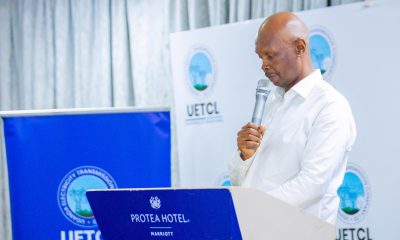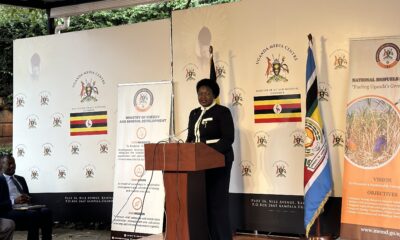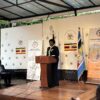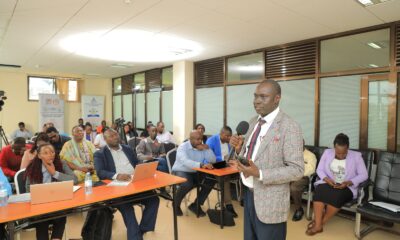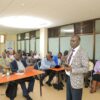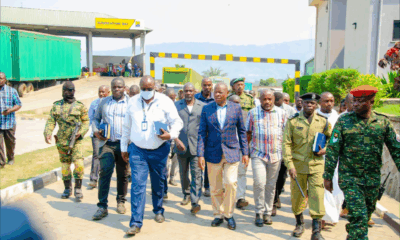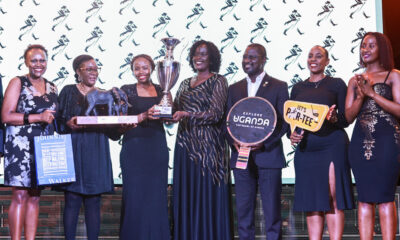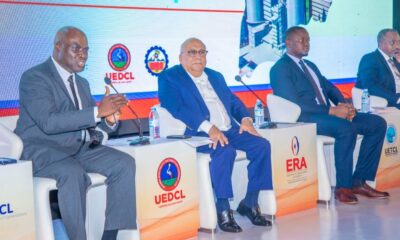Business
Dark Country: How government is struggling to meet rural demand for electricity
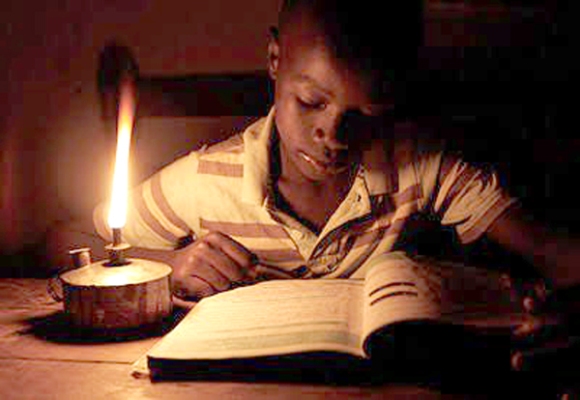
A child struggles to read on a “tadooba” (Kerosene lamp)photo credit: Florence Kyalimpa
Safina Kadondi, a teenager in Kinyoli village, Namanyonyi Sub County, Mbale district, has an arm and a leg crippled. This makes it difficult for her to walk. As each day closes, another challenge resurfaces – darkness.
She is the eldest daughter at their home and has to do the cooking. Her mother sells sugarcanes at a nearby trading centre and only returns home after 10pm.
“I use a kerosene lamp at night and since it does not provide sufficient light I always suffer,” she says.
When the lamp runs dry Kadondi has to brave a three kilometer walk to a refill station in Nkoma trading centre in order to buy kerosene.
“I can spend four hours on a journey that others walk for 30 minutes to and fro. We buy a litre at UGX 2700 which works for six or seven days,” she says.

Fafina Kadondi finds it hard to do her homework
To cook food, Kadondi uses firewood. “Smoke goes into my eyes and they hurt,” she says.
Access to electricity in this village, due to high charges, has been left for the rich who are, as it appears, new occupants.
Naula Mwajuma, one of the residents says one is required to pay a sum of UGX 600,000 before an electric pole is extended to their premises.
“We can see the main wires but the problem is with the poles to extend electricity to our compound. We tried the alternative of promotional electricity but whenever I go there, they tell me that they are first working on those who applied first,” she says.
Like in Namanyonyi, Namabasa Sub County residents are also facing the same challenge of lack of electricity
Aisha Nalukenge graduated in Computer Sciences at the Islamic University in Uganda (IUIU) in 2016 and got married in Namabasa Zone IV. Nalukenge has a printer, photocopiers, a computer and other machines just rotting in the house because there is no access to electricity where she got married.
“My husband stopped me from moving to Mbale town, which is seven kilometers away, for work. I had no choice but to put my machines in the house,” she says.
Residents of these two sub counties move a distance between four and seven kilometers to access grinding mills, salons or computer services.
Residents’ appeal
On 30th October 2010 residents of five villages including Namabasa Zone III, Namabasa Zone IV, Namabasa Zone V, Doko Zone and Kolonyi Zone II, through their leaders, wrote a letter to the Executive Director Rural Electrification Agency (REA) requesting for electricity to be extended to their area. In 2011, a team from the area physically visited the offices of REA in Kampala to follow-up on their request.
“Accompanied by our area MP Gashomu Wambede we met the Deputy Executive Director Godfrey Welikhe who assured us that we were going to be connected but to date nothing has been done,” Rashid Wangaya, the former LCI Chairman of Namabasa Zone IV,” says.
Wangaya adds that after realizing that their earlier efforts were futile, they wrote to UMEME on March 11, 2014, requesting for electricity. “UMEME told us that they are not responsible for extending power. Their work is to connect houses and our hopes ended there,” he says.
On January 26, 2019, residents of the three sub counties of Namabasa, Nakaloke and Namanyonyi petitioned the President seeking his direct intervention on their access to the rural electrification program.
The petition was received by senior presidential adviser Milly Babirye Babalanda on January 29, 2019.
The President wrote a letter to the Ministry of Energy and Mineral Development on 30th January calling for instant response but to date nothing has been done.
Access to electricity a national problem
The problem of low power connections affects rural areas on a national scale.
Information from the Uganda Bureau of Statistics indicates that only five percent of the rural households were by 2016 connected to grid electricity, and when all other forms of modern energy were included, electricity connectivity for rural households was only 10.3 percent.
Figures from the World Bank’s Sustainable Energy for All (SE4ALL) Global Tracking Framework show that 22 percent of the total population of Uganda had access to electricity in 2017. Electricity coverage for urban areas was at 57 percent and 11.4 percent for rural area in the same year.
The seventh Sustainable Development Goal calls for access to affordable, reliable, sustainable and modern energy for all citizens by 2030. The National Development Plans I of 2010-2015 and II of 2015-2020 prioritized investment in energy infrastructure to improve the country’s competitiveness and foster accelerated socio-economic transformation. But how is Uganda performing?
Is REA meeting its targets?
The 2001-2010 Rural Electrification Strategy and Plan (RESP) which was aimed increasing rural electricity access from one percent in 1999 to ten percent by 2012 did not meet the target.
According to the REA website, RESP was formulated with the aim of connecting to the grid an additional 400,000 rural households by 2010.
The 2013-2022 RESP baseline assessment shows that at the close of the first RESP, less than five percent of the rural population had electricity.
The 2010 Auditor General’s Report on the Implementation of the Rural Electrification Programme REA indicates that,
REA was expected to connect at least an additional 400,000, which was 10 percent rural electrification access by 2012, broken down as 20,000 in the financial year (FY) 2005/06, 30,000 in 2006/07, 50,000 (FY 2007/08) and 300,000 71 (FY 2008/09- 2011/12). And these additional connections would be distributed as 220,000 on main grid, 100,000 on independent grids and 80,000 on solar-PV. However, an analysis revealed that there were low connections compared to the planned connections, showing performance levels of 39 percent, 31 percent and 26 percent in the FYs 2006/07, 2007/08 and 2008/09 respectively.
The 2013-2022 RESP seems to be also inheriting the failures of its predecessor. Though the program is aimed at achieving a rural electrification access of 26 percent by 2022, 51 percent by 2030 and 100 percent in 2040, its performance is below the expectations.
By 2022, 1.28 million on grid new connections and 140,000 off grid new connections are expected to be made under this program.
The 2014 Uganda National Housing and Population Census estimated 52 percent of households used tadooba (kerosene lamp) as the main source of energy for lighting while about 20 percent used electricity.
The report further shows that tadooba was predominantly used in the rural areas (60 percent) as compared to the urban area.
The report further estimated that 85 percent of the total population lived in rural areas and engaged in subsistence economic activities with negligible value addition partly due to lack of electricity.
In November 2018, the government launched the 2018-2027 Electricity Connections Policy (ECP) seeking to achieve a 60 percent level of access to electricity for Uganda by 2027.
The policy also aims at increasing the number of connections made annually from the current average of 70, 000 to 300,000 by 2027. It also aims to increase electricity demand on the main grid by 500MW by 2027, 80 percent of these connections are expected to be made upon completion of wiring of premises.
REA speaks out
Dr. Patricia Litho, the Head of Communications and Community Affairs at the REA, says the agency is performing well and currently they have started the program of connecting Sub Counties.
“There must be a target against which we are judged. Because we follow a strategic plan for example when REA was first set up about 16 years ago, it was rural electrification strategy and plan. All the projects that were set have been implemented,” she says.
She adds: “as REA, we always have a projection and target populations. We carry out feasibility studies before we start these projects but by the time we start implementing, you find people coming up, interests increasing. You end up saying that we did not meet the target.”
On-going government efforts
While presenting the sector performance report during the NRM manifesto week recently, Energy Minister Irene Muloni said that by May this year, the government had implemented extension of over 10,000km of medium voltage (MV) power lines and 9000km of lower voltage (LV) distribution power lines which had translated into connections of over 700,000 customers onto the national grid. This, she said, had increased rural electricity access from 1 percent in 2001 to 13 percent.
How the ECP will achieve 60% connections by 2027
The policy assumed that the population growth rate is at three percent. It was estimated that the number of households in Uganda will be 10,506,538 by 2027. The policy will aim at reaching 60 percent connection rate by the year 2027 representing 6,303,923 connections both on grid and off grid.
It was therefore estimated that two percent of connection targets equivalent to 126,078 connections will come from the mini-grid connections. Thirty one percent of the connection target equivalent to 1,954,216 connections will come from off grid standalone solar systems and the remaining 67 percent target equivalent to 4,223,628 connections will be achieved on the grid.
This basis was derived from the United Nations Sustainable Energy for All action plan (SE4ALL) and will be adopted for the ECP.
The SE4ALL aims at achieving universal electricity access by 2030. The plan provides for 67 percent of the access target to be achieved on the grid and 33 percent (31 percent on standalone solar systems and two percent on mini-grids) on the off grid.
Dr. Litho says that at least 160,000 connections have been made country wide since the Electricity connection policy was launched in November last year.
Current electricity capacity
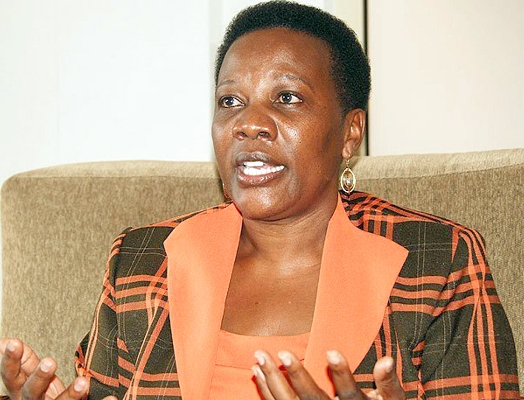
Energy Minister Irene Muloni
The 2015 figures from the Uganda Bureau of Statistics (UBOS) indicate that the total installed capacity of electricity power plants increased by 4.8 percent from 827.5 MW in 2013 to 867.0MW in 2014.
The 2018 figures from UBOS further indicate that the total installed capacity of electricity power sources increased by 5 percent from 895.5 MW in 2016 to 937.8 MW in 2017.
The 2018 Hydropower Status Report from the International Hydropower Association indicates that Uganda’s total installed power generation capacity is 957.7 MW, 743 MW from hydropower (78 percent of the total), 14 percent from Thermal, 10 percent cogeneration and one percent from solar energy.
Current Figures from the Electricity Regulatory Authority (ERA) indicate that the total amount of electricity supply is 984.0 MW in the country, 967.5 MW from grid supply and 7.5 from mini grid and other forms of energy.
Comments



